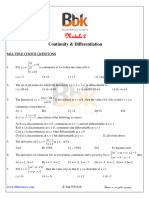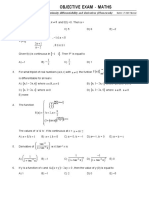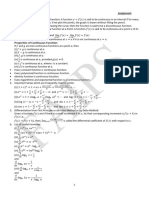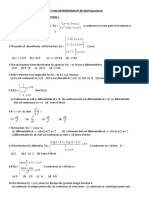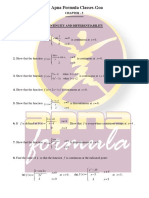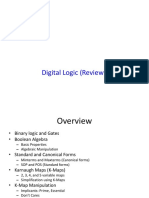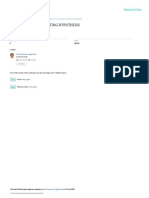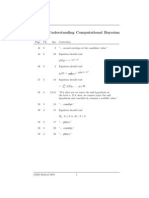Ch-5.
Continuity and Differentiability
1
Q1 The number of points at which the function f (x) = is not continuous is
x − [x]
(A) 1 (B) 2 (C) 3 (D) None of these
Q2 The function given by f (x) = tan x is discontinuous on the set
n
(A) {n : n Z} (B) {2n : n Z} (C) (2n + 1) : n Z (D) : n Z
2 2
Q3. Let f (x) = |cos x|. Then,
(A) f is everywhere differentiable. (B) f is everywhere continuous but not differentiable at n = nπ, n Z
(C) f is everywhere continuous but not differentiable at x = (2n + 1)π/2, n∈ Z .
(D) none of these.
04. If f (x) = x + x − 1 , then which of the following is correct?
(a) f (x) is both continuous and differentiable, at x = 0 and x = 1
(b) f (x) is differentiable but not continuous, at x = 0 and x = 1
(c) f (x) is continuous but not differentiable, at x = 0 and x = 1
(d) f (x) is neither continuous nor differentiable, at x = 0 and x = 1
Q5 State whether the statements in each of the Examples 42 to 46 is True or False :
(i) |sin x| is a differentiable function for every value of x.
(ii) cos |x| is differentiable everywhere.
Q6 The set of points where the functions f given by f (x) = |x – 3| cos x is differentiable is
(A) R (B) R – {3} (C) (0, ∞) (D) None of these
1
Q7. The number of points at which the function f (x) = is discontinuous is ______________.
log | x |
1
sin ,if x 0
8. The value of k which makes the function defined by f (x) = x , continuous at x = 0 is
k,if x = 0
(A) 8 (B) 1 (C) –1 (D) None of these
4−x 2
9. The function f (x) = is
4x − x 3
(A) discontinuous at only one point (B) discontinuous at exactly two points
(C) discontinuous at exactly three points(D) none of these
1 − sin 3 x
, for x
10. If f (x) = 3cos x
2
2 is continuous at x = , then the value of k is
k , for x = 2
2
3 1 1
(a) (b) (c) (d) 1
2 6 2
11 Find the value of k, for which the function f defined below is continuous :
k cos x π
π − 2x , x 2
π
f ( x ) = 3, x = .
2
3tan 2 x π
2 x − π , x 2
x 3 + x 2 − 16x + 20
,if x 2
12. If f (x) = (x − 2) 2 is continuous at x = 2, find the value of k.
k,if x = 2
� 1
x sin ,if x 0
13 Show that the function f defined by f (x) = x is continuous at x = 0.
0,if x = 0
14. Let f (x) = x |x| , for all x ∈ R. Discuss the derivability of f (x) at x = 0
3
15 If f (x) = | cos x | , find f .
4
16. If f (x) = 2 cos x − 1 , x , find the value of f so that f (x) becomes continuous at x = .
cot x − 1 4 4 4
e1/ x − 1
,if x 0
17. Show that the function f given by f (x) = e1/ x + 1 is discontinuous at x = 0.
0,if x = 0
1 − cos 4x ,if x 0
x2
18. Let f (x) = a,if x = 0 . For what value of a, f is continuous at x = 0?
x
,if x 0
16 + x − 4
2x + 3,if − 3 x −2
19. Examine the differentiability of the function f defined by f (x) = x + 1,if − 2 x 0
x + 2,if 0 x 1
x + 3x + p,if x 1
2
20 Find the values of p and q so that f (x) = is differentiable at x = 1.
qx + 2,if x 1
21 Find the value of ‘a’ for which the function f defined as a sin 2 (x + 1), if x 0 is continuous at x = 0.
f (x) =
tan x − sin x , if x 0
x3
x[x],if 0 x 2
22 Examine the differentiability of the function f defined by f (x) = at x = 2
(x − 1)x,if 2 x 3
2 1
x sin ,if x 0
23 Examine the differentiability of the function f defined by f (x) = x at x = 0
0,if x = 0
24 A function f : R → R satisfies the equation f (x + y) = f (x) f (y) for all x, y ∈R, f (x) ≠ 0. Suppose that the
function is differentiable at x = 0 and f ′(0) = 2. Prove that f ′(x) = 2 f (x).
sin(a + 1)x + 2sin x
, if x 0
x
25. If f (x) = 2, if x = 0 is continuous at x = 0 , then find the values of a and b.
1 + bx − 1 , if x 0
x
3 sin x + cos x
, x−
6
26. For what value of k, is f (x) = x+ continuous at x = − ?
6 6
k, x = −
6
1)D 2)C 3)C 4)c Q5(i) False(ii).True. 6)B 7)3 8)D 9)C 10)C 11)k=6 12)k=7 14)diff 15.1/√2
16..1/2 18. a = 8 19. function f (x) is not differentiable at x = –2 and 0
20 p = 3, q = 5 . 21 a = 1/2 22 f is not differentiable at x = 2.
23 f ( x ) is differentiable at x = 0 . 25. a = −1, b = 4 26. k = 2




